
Editor’s note: This is a guest post from Creek Stewart of Willow Haven Outdoor.
I’m a smart man. I have surrounded myself with a very beautiful group of girls who tirelessly landscape my yard, provide rich compost for my garden, dispose of my kitchen scraps, handle insect control around the house, keep me company, and even make me a fresh breakfast each morning. These highly productive females in my life are not actually human. They are chickens, though I affectionately refer to them as my lovely lady lumps.
I consider my small flock of backyard chickens to be one of the best investments I’ve ever made – even though they cost very little time, energy, or money. If you are interested in having a harem of hens in your life like mine, below is some insight about how to get started.
The Perks of Raising Backyard Chickens
Some of you might be wondering – why chickens? Let’s get this question out of the way first. Several years ago, raising chickens was something that only people in the country did. Chickens were associated with farms and wide open spaces. Not anymore! I would actually consider backyard chickens to be a modern cultural phenomenon. Thousands of families are adding a small flock (2-5) to their backyard, right next to the doghouse. When I bought my first house it only had a 20’x20’ backyard. The first thing I did was put in a small chicken coop with three hens, which is the perfect number for starting out. The biggest misconception with raising chickens is that you need to live in the country. This is simply not true. Yes, local regulations or neighborhood ordinances may impact your decision, but many communities are very chicken friendly or easily convinced otherwise.
In my experience, there are many benefits to raising a small backyard flock. Let’s explore some of my favorites.
- Fresh Eggs: Fresh eggs are the most obvious reason, or as I like to call them, “Hen Berries.†Hens will start laying eggs at about 6 months old. They will consistently lay an egg every 1-2 days for several years. These eggs, especially when the chickens are given kitchen scraps and/or allowed to free range, are more flavorful than anything you’ll ever find in the store.

My morning selection of fresh eggs.
- Composting: Chickens are amazing compost factories. They will turn almost any kitchen scrap into a nutrient rich garden additive – poop. They love vegetable scraps, bread, grains, and even meat scraps. We’ll get more into food later.

Chicken-landscaped tree.
- Landscaping and Insect Control: If you allow your chickens to free range (roam out of the coop), they will meticulously landscape around your trees and shrubs. They will also hunt down insects like trained ninja assassins. I often call them my little T-Rexes. I’ve seen them eat every kind of insect you can imagine, as well as snakes, mice, minnows from the shallow edge of our pond, and even a fallen baby bird. They are vicious killers and their distant connected ancestry to majestic birds of prey can be seen when you look into their eye. However, they love fresh grass and plant shoots as well and will happily weed your garden (or planters) once it is established.
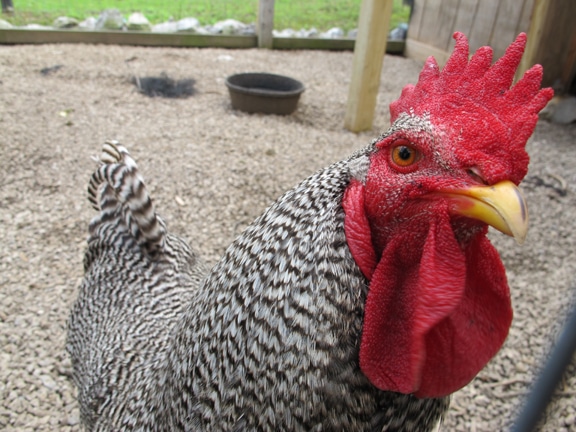
Look into the eye of a merciless killer.
- Pets: Yes, that’s right, chickens make great pets. When you raise and handle chickens from small chicks they will gladly eat from your hand, sit in your lap, and follow you around the yard. They will also happily poop in your lap as well. They’ll come to you when you call and wait for you at the door. They have great personalities. They are incredibly curious and forage for food tirelessly. They rise early and like to go to bed just before dusk. They are absolutely the most low maintenance pet (except for maybe a goldfish) that you can own. As long as they have fresh food, water, and a clean coop, they will be happy as can be. They aren’t needy like many animals and are just as happy when you’re not home. I leave my hens for days at a time with no problems.
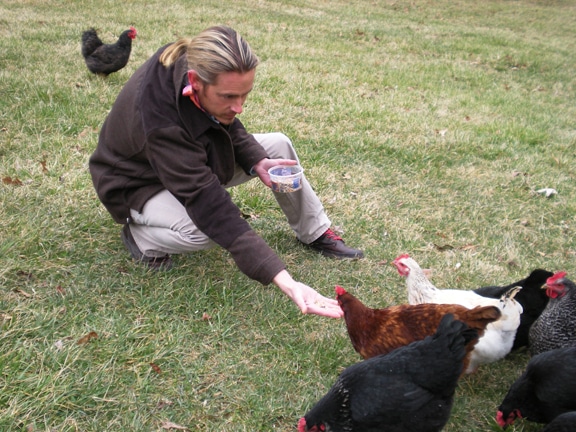
Creek hand-feeding his flock.
- Self-reliance: As a survival instructor at Willow Haven Outdoor, chickens represent a long-term survival strategy. If a time ever comes when food is not so readily available, one can easily scale up a small backyard flock of chickens to help supplement food shortages. As you know, chickens produce eggs, but they also produce chicken. There is something magical about knowing exactly where your food comes from. I know what my chickens eat and therefore know what I’m eating – it’s a simple formula that I quite like.
- Beauty: It’s easy to take a simple backyard chicken for granted, but many of them have plumage that will rival even the most radiant tropical bird. I’ve owned chickens that were absolutely stunning to look at. The number of chicken breeds to choose from is astounding; from metallic blues and greens to lace-tipped gold feathers, many are truly a natural marvel to behold. I’m often amazed that a bird this beautiful is just walking around in my backyard. Some people raise chickens just for this reason. In fact, there are avid fishermen who raise certain breeds of chickens just to use the feathers for tying high-priced fishing flies.
Raising backyard chickens is simple. As long as you’ve got the basic survival necessities covered you’ll be just fine. Chickens have the same survival needs as we do – shelter, water, and food.
What You Need to Raise Backyard Chickens
Shelter
Some of you may want to raise chickens from small chicks or even hatch your own eggs in an incubator at home. Others may want to skip all of that and buy adult hens already laying eggs. Shelter for baby chickens (chicks) is different from teenagers and adults. I’ll break shelter down into two main categories based upon chicken age.
Shelter for Chickens Less Than Two Months Old
Spring is the best time to get started in raising small chicks. I keep all of my baby chicks inside my home or garage for the first two months. Many farm supply stores carry live baby chicks around Easter, so now is a perfect time to pick up a couple. Unfortunately, it’s difficult to tell girls from boys at this age so you just have to take your chances. Girls (hens) are the only ones that lay eggs, and it takes 4-5 months for baby female chicks to start laying them. Craigslist is also a great place to find chicks (and even laying hens) locally. But, if you want to see something really amazing, order an incubator and fertilized eggs on-line and hatch them yourself. The newborn chicks will make an imprint on you and form a much stronger bond. Backyardchickens.com is a great resource to find both incubators and fertilized eggs.
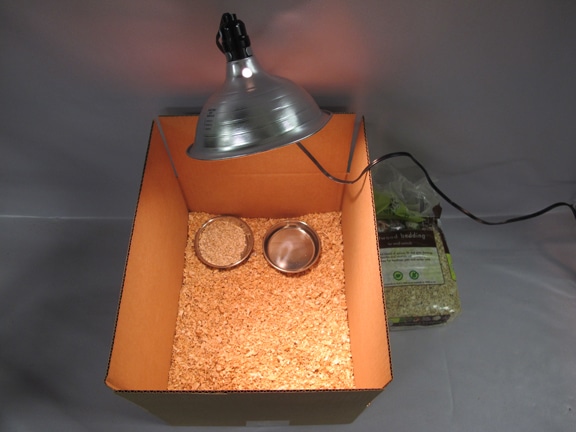
Baby chick cardboard box coop.
I’ve found the best shelter for the first 2 months of raising baby chicks is a good old cardboard box. Regulating temperature is critical for small chicks. This is best done with a heat lamp. Or, you can just use a cheap shop light and standard light bulb. A thermometer in the box will help you adjust the lamp accordingly to regulate temperature. Below are the general temperature ranges for the first several weeks:
Week 1: 95 Degrees Fahrenheit
Week 2: 90 Degrees Fahrenheit
Week 3: 85 Degrees Fahrenheit
Week 4: 80 Degrees Fahrenheit
Week 5: 75 Degrees Fahrenheit
Week 6: 70 Degrees Fahrenheit or room temperature
Week 7: 65 Degrees Fahrenheit or room temperature
Week 8: Room temperature
I’ve found that pine shavings from a local pet store work really well as flooring for your baby chick coop. Chickens are little poop factories so the wood shavings really help with that. I’ve also used newspaper as well. The last two pieces are food and water bowls. Any shallow bowl (no higher than 2 inches) will work just fine. The little chicks need to be able to reach over the rims. You can cut down old butter or whipped cream bowls or buy bowls that suit your needs. You can buy special formulated chick food at farm supply stores called baby chick crumbles or starter ration, but I grew up raising baby chicks on Quaker oats and chopped up vegetable scraps. Chickens grind up the food in their gizzard with little rocks and pieces of sand so it’s important to mix in a little sand with the oats if you go this route. Most of the store-bought feed has this mixed in. The two most important concerns are regulating temperature and keeping a full water bowl. Like humans, these are top survival priorities.
Shelter for Chickens Two Months and Older
Once the chickens reach two months old I move them into my outdoor coop, assuming it’s not the dead of winter. There are literally thousands of different outdoor coop designs. Just do a quick Google search for “chicken coop†and you’ll see what I mean. I normally keep 3-5 chickens in a coop that has a footprint of 4×8 feet. You can buy coop kits on-line or download plans for free. I bought the one in these photos from a guy who makes them and sells them locally on Craigslist. I built my first chicken coop, however, from scrap supplies. I also prefer coops that are mobile, commonly referred to as chicken tractors. These normally have wheels on one side and allow you to move it around the yard so that your hens can free range a bit. When it comes to outdoor chicken coops there are several important details.
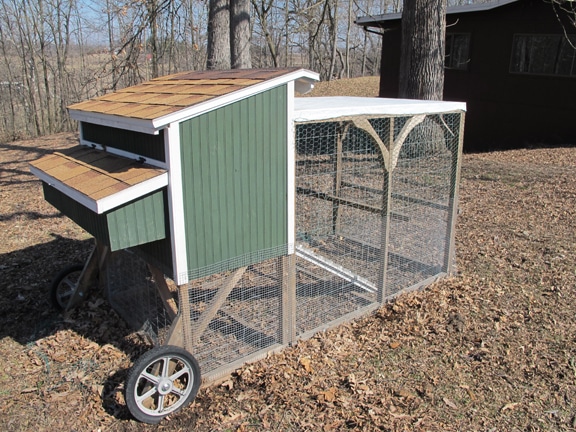
My mobile, 4×8 enclosed chicken coop.
- Security: Security is the #1 purpose of a coop. Chickens, even though merciless birds of prey for anything smaller than a deck of cards, are at the bottom of the food chain and are considered a delicacy by pretty much every predator. In the past, my chickens have been killed by weasels, minks, cats, raccoons, dogs, and even hawks. The term ‘chicken hawk’ takes on a whole new meaning when you’re admiring your hens in the yard from the window and a big hawk comes down and flies off with one dangling from its talons. I’ve concluded that a chicken coop should be wrapped 360 degrees in wire cage. The wire holes should be no larger than 1 inch. There should be no cracks or loose boards where something could slip inside. Where there is a will, there is a way. I’ve seen predators slip through the smallest cracks. All doors should be locking; raccoons are a huge threat and I’ve seen them open simple latches.
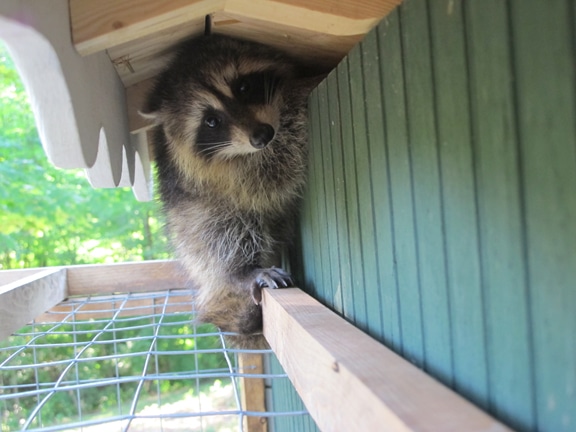
Raccoon trying to slip through crack in coop.
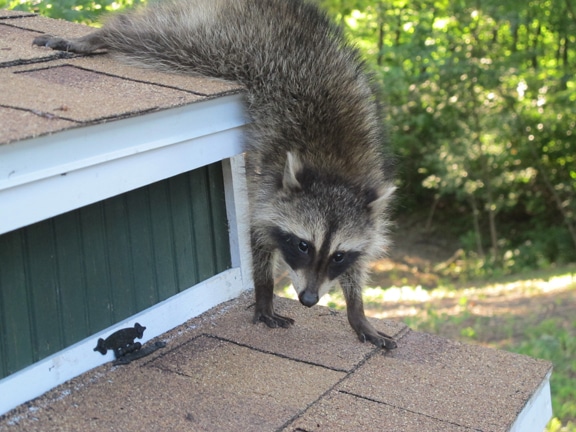
Raccoon trying to figure out a way into the coop.
- Run Space: All coops should have a space for chickens to forage and get some fresh air. I’ve found that my 4×8 coop is perfect for three hens.
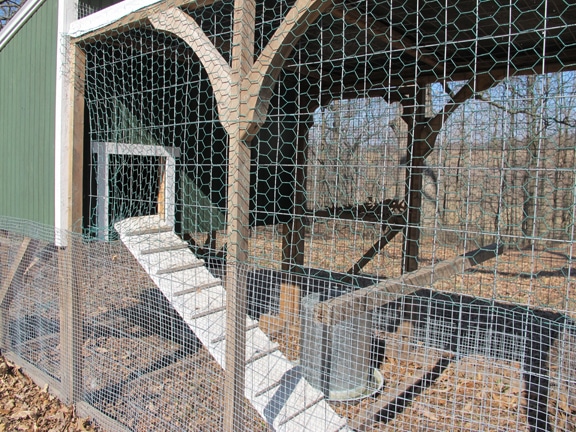
Wire mesh enclosure to protect from predators.
- Elevated Roost: Though I’ve seen open-air roosting coops, I prefer my chickens to have an elevated and enclosed roosting area. Like most birds, chickens have a natural roosting instinct and will roost in high areas (even trees if you let them). This space should be sheltered but also ventilated, especially during hot summer months. The roosting area typically includes a roosting perch bar where the chickens will sleep. Remember, they are driven by thousands of years of genetically wired instincts, so to them, it’s just a tree branch.
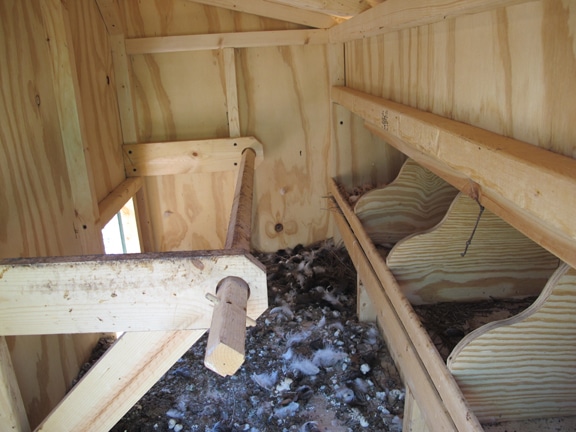
Covered and enclosed roosting perch.
- Roof: Coops should have a roof to protect from sun, snow, and rain.
- Nesting Boxes: All coops should have nesting boxes. These are just little 12â€x12â€x12†spaces for hens to lay their eggs. I put straw or wood shavings in my nesting boxes. Typically, these are integrated into the roosting area.
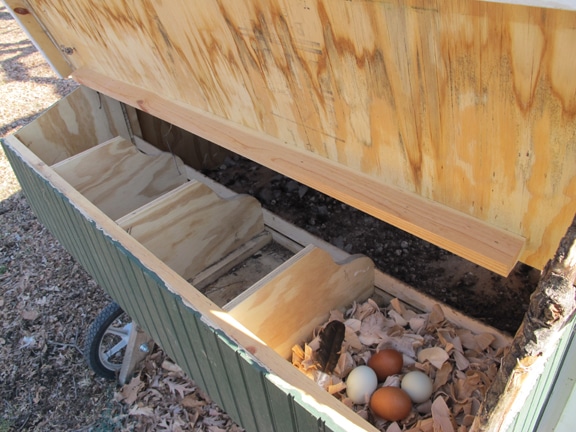
Nesting boxes with easy-access lid.
- Mobile Coops: I like mobile coops for many reasons. With stationary coops, chickens will strip the ground down to bare earth in a matter of days. Then to keep it from getting muddy and nasty you’ll need to cover the ground with hay, pea gravel, sand, or wood chips. I’ve seen three hens completely strip a 4×8 space in about 2 days. Mobile coops allow you to move the coop around your yard and still let the chickens free range on fresh grass and insects without letting them out of the coop. Mobile coops also allow you to situate the coop in ideal spots out of the sun or under a tree. You can let your hens out to free range with stationary coops, but you need to keep an eye out for predators. They love to free range around flower pots, gardens, trees, and landscaping. I always let my hens out of the coop when I’m doing work in the yard or when I’m close by where I can keep an eye on them.
- Heat: I do not heat my coop in the winter. Chickens are covered in thick downy feathers and if other birds can weather the temperatures so can they.
Chicken Food
Remember, you are ultimately eating what you feed your chickens. I like to let my hens free range as much as possible and they absolutely LOVE leftover dinner and kitchen scraps. And, chickens love chicken, eggs, and egg shells. I know, it sounds a little gross, but they do. Don’t hesitate to give them your scrap egg shells or cold chicken sandwich. They will make quick work of about any kitchen scrap you throw their way including, but not limited to, watermelon rinds, apple cores, potato peels, grapes, egg shells, meat scraps, stale bread, crackers, bacon, and the list goes on and on.
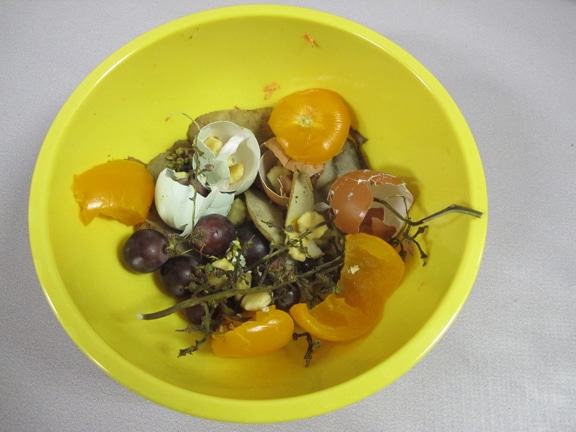
Delectable chicken buffet.
I also purchase Purina Brand Crumbles from a local farm supply store to supplement their diet, especially in winter. My mom grew up feeding their chickens strictly whole corn kernels. Bottom line, chickens have a very versatile diet. Invest in a durable chicken feeder and keep it clean. Check it at least every other day and make sure your crumbles or grain isn’t moldy or wet.
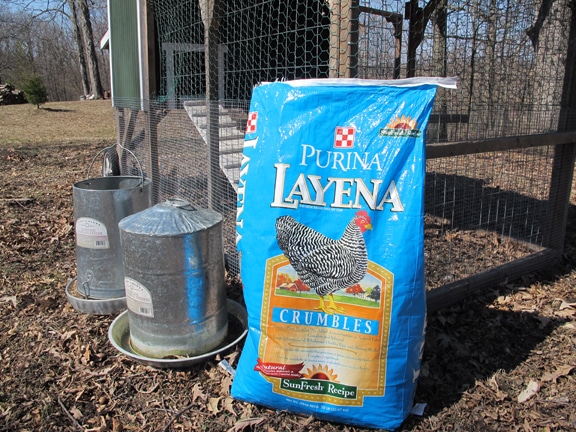
Food and water containers with Purina Crumbles.
I also keep some sand handy for the hens to pick through. They use what’s called grit (pieces of sand and gravel) to grind up the food in their gizzard. A bowl full of sand is perfect. Crushed oyster shells (also found at your local farm supply store) are great for extra calcium. This also makes their egg shells nice and strong.
Water
Like all living things, chickens need fresh water. There are many different chicken watering buckets on the market. I use a 5-gallon version because I have to fill it less often. I use a heated watering bowl in the winter.
Conclusion
Whether you’ve got empty-nest syndrome or you just don’t want to put all your eggs in one basket, chickens have a lot to offer people from all walks of life. They are inexpensive to farm and won’t break the bank even if you’re just scratching out a living or trying to save up a nest egg. But don’t take my word for it. Birds of a feather flock together so I’d recommend checking if there are any local poultry clubs in your area. They will let you know if raising backyard chickens isn’t everything it’s cracked up to be. Don’t be afraid to stick your neck out and hatch a coop idea of your own. I’ve seen coops made from Volkswagen Beetle frames and ones that resemble Hobbit homes from Lord of the Rings. There’s nothing that ruffles my feathers more than when people say there’s only one way to cook an egg. There are all kinds of creative ways to care for and raise chickens. If you want to start a backyard flock quit running around like a chicken with its head cut off and get on with it. If you want to and don’t, then well…you’re just plain chicken.
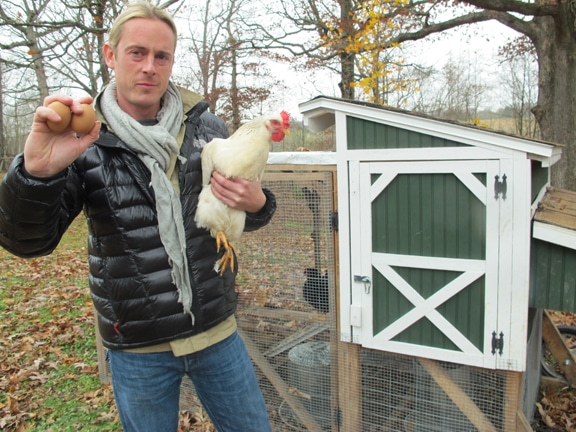
Proud chicken owner.
FAQs
Below is a short list of questions I’m commonly asked about my chickens from guests who attend our survival courses:
Q: Why don’t you have a rooster?
A: Roosters are beautiful birds but unless you want to fertilize your eggs and hatch more chickens, roosters are pretty much worthless. They do not lay eggs, but without one, your hens’ eggs cannot be hatched into more chickens if you wish to do so. When I hatch eggs, I typically eat the roosters when they are 5-6 months old.
Q: What breed of chickens do you like best?
A: There are tons of different breeds. Some are fluffy, some are solid white and smooth, some lay green eggs, and some lay brown eggs. I like them all but my favorites are Easter Eggers, Barred Rocks, Rhode Island Reds, and Americana/Araucanas. I personally like a variety of egg colors; they make great gifts.
Q: Why do you raise chickens?
A: I like the idea of producing some of my own food. I also like that I could scale up production and really supplement my food needs with chickens if necessary.
Q: How often do your chickens lay eggs?
A: Almost every day in spring, summer, and fall and less frequently in winter.
Q: Do chickens have any health problems?
A: Like all animals, chickens can get sick. It’s often difficult to diagnose. Your best bet is to check the forums on popular chicken sites such as Backyardchickens.com for other owners who have had similar problems. In general, though, chickens are very healthy and easy to care for. I’ve only had one die from being sick.
____________________
Creek Stewart is a Senior Instructor at the Willow Haven Outdoor School for Survival, Preparedness & Bushcraft. Creek’s passion is teaching, sharing, and preserving outdoor living and survival skills. Creek is also the author of the books Build the Perfect Bug Out Bag: Your 72-Hour Disaster Survival Kit and the upcoming Unofficial Hunger Games Wilderness Survival Guide — due out in May. For more information, visit Willow Haven Outdoor.


